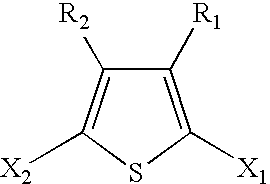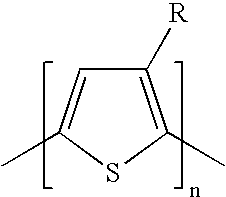Halogenated thiophene monomer for the preparation of regioregular polythiophenes
a technology of regioregular polythiophene and halogenated thiophene, which is applied in the field of forming conductive polymers, can solve the problems of reducing electronic and photonic properties, reducing the cost of synthesis, and increasing the need for purity
- Summary
- Abstract
- Description
- Claims
- Application Information
AI Technical Summary
Problems solved by technology
Method used
Image
Examples
example 1
[0033] 5-Bromo-2-chloro-3-hexylthiophene (10 g, 0.0355 mol) was added over a period of 30 min to a mixture of 75 ml 2-methyltetrahydrofurane, magnesium (0.86 g, 0.0355 mol) and 0.15 ml of a 1 molar solution of tert-butylmagnesiumchloride solution in THF at a temperature of 60-70° C. The mixture was stirred for an additional 1.5 h at 70° C. At 60° C. a suspension of Ni(dppe)Cl2 (93 mg, 0.177 mmol) in 12.5 ml 2-methyltetrahydrofurane was added to the reaction mixture over a period of 30 min and then the mixture was stirred for additional 3 h at 80° C. Triethylphosphite (0.5 g, 3 mmol) was added to the reaction mixture and the mixture was stirred for additional 30 min at 80° C. Next, trace metals were removed using conventional distillation and filtration techniques. After trace metals were removed, the remaining material was dissolved in 10 ml toluene and added to 100 ml of ethyl acetate, creating a suspension. The suspension was then stirred for 30 min at 80° C., cooled down and filt...
example 2
[0034] 5-Bromo-2-chloro-3-hexylthiophene (10 g, 0.0355 mol) was added over a period of 30 min to a mixture of 75 ml 2-methyltetrahydrofurane, magnesium (0.86 g, 0.0355 mol) and 0.15 ml of a 1 molar solution of tert-butylmagnesiumchloride solution in THF at a temperature of 60-70° C. The mixture was stirred for additional 1.5 h at 70° C. At 60° C. a suspension of Ni(acac)2 (45.6 mg, 0.177 mmol), 1,3-bis(2,4,6-trimethylphenyl)imidazolium chloride (121 mg, 0.355 mmol) and tert-butylmagnesiumchloride solution (0.71 ml, 1 m in THF) in 20 ml 2-methyltetrahydrofurane was added to the reaction mixture over a period of 30 min. The reaction mixture was stirred for additional 3 h at 80° C. Triethylphosphite (0.5 g, 3 mmol) was added to the reaction mixture and the mixture was stirred for additional 30 min at 80° C. Trace metals were removed using conventional techniques and a polythiophene product was separated out. The process yielded 2.68 g (45%) poly(3-hexyl)thiophene having a regioregulari...
example 3
[0035] 5-Bromo-2-chloro-3-hexylthiophene (10 g, 0.0355 mol) was added over a period of 30 min to a mixture of 75 ml 2-methyltetrahydrofurane, magnesium (0.86 g, 0.0355 mol) and 0.15 ml of a 1 molar solution of tert-butylmagnesiumchloride solution in THF at a temperature of 60-70° C. The mixture was stirred for additional 1.5 h at 70° C. At 60° C. a suspension of Ni(dppp)Cl2 (160 mg, 0.355 mmol) and tert-butylmagnesiumchloride solution (1.35 ml, 1 m in THF) in 20 ml 2-methyltetrahydrofurane was added to the reaction mixture over a period of 30 min. The reaction mixture was stirred for additional 3 h at 80° C. Triethylphosphite (0.5 g, 3 mmol) was added to the reaction mixture and the reaction mixture was stirred for additional 30 min at 80° C. Trace metals were removed using conventional techniques and a polythiophene product was separated out. The process yielded 3.28 g (55%) poly(3-hexyl)thiophene having a regioregularity of 91%. Other properties included: Mn=10596, Mw=18303, UV (C...
PUM
| Property | Measurement | Unit |
|---|---|---|
| mol % | aaaaa | aaaaa |
| temperature | aaaaa | aaaaa |
| temperature | aaaaa | aaaaa |
Abstract
Description
Claims
Application Information
 Login to view more
Login to view more - R&D Engineer
- R&D Manager
- IP Professional
- Industry Leading Data Capabilities
- Powerful AI technology
- Patent DNA Extraction
Browse by: Latest US Patents, China's latest patents, Technical Efficacy Thesaurus, Application Domain, Technology Topic.
© 2024 PatSnap. All rights reserved.Legal|Privacy policy|Modern Slavery Act Transparency Statement|Sitemap



